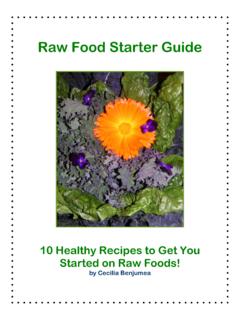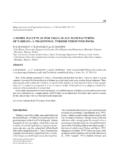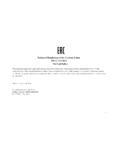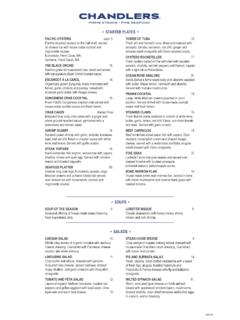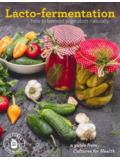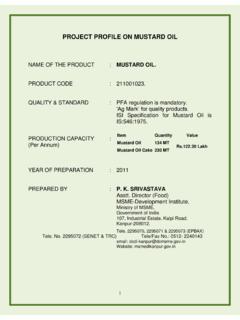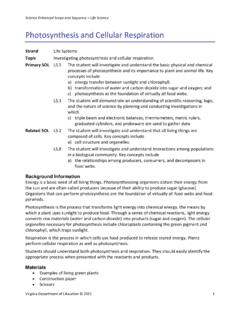Transcription of Socio-economic context and role of agriculture
1 FAPDA - food and agriculture Policy Decision AnalysisMalawiCountry faCt sheet on food and agriculture poliCy trendsMarCh 2015 Socio-economic context and role of agricultureMalawi is a landlocked country in Southern Africa, with an economy driven predominantly by the agricultural sector that accounts for one third of the GDP and nearly 80 percent of employment. agriculture is considered the engine of Malawi s economic growth since, between 2005 and 2011, more than 80 percent of the country s total exports were agricultural commodities, primarily tobacco, sugar and tea. Tobacco alone however, represents an average 60 percent of Malawi s total The manufacturing and agricultural sectors work together in their contribution to the overall growth of the economy, which in 2013/14, registered an average GDP growth rate of percent. In particular, the 2013 growth in manufacturing was attributed to usage of higher volumes of raw agricultural inputs and a more constant supply of fuel and other raw materials.
2 Malawi remains among the five poorest countries in the world, with over 50 percent of the population living below the poverty line and one quarter considered ultra-poor . Furthermore, about half of all children are suffering from acute or severe malnutrition. The high incidence of rural poverty in Malawi is both caused and reinforced by low pro-ductivity and small farm The Malawian minimum wage, Selected indicators2007200920112013 socio -ECONOMICGDP (current billion US$) * per capita (US$) *266345364266 Agricultural value added (% of GDP) *32313027 Agricultural value added (annual % growth) *(average 2007-2013) (2013) population (thousand)1. 71414 57315 45816 363 Rural population (% of total) labour force (% of total labour force) Development Index **(2013) (ranking 174)AGRICULTURAL PRODUCTION & TRADEPer capita cultivated land (ha) equipped for irrigation (ha)74 000 Value of total agriculture production (constant gross value 2004-2006, billion US$)2 5234 1454 683 NAValue of cereals production (constant gross value 2004-2006, billion US$)5661 3941 516 NAYield for cereals (hg/ha)24 67021 24320 94320 688 Cereal import dependency ratio (%)(2007-2009) 3 commodities Production quantityCassava, Potatoes, Maize (2012)Production valueCassava, Potatoes, Maize (2012)Import quantityWheat, Tobacco ( unmanufactured), Soybean oilImport valueWheat, Tobacco ( unmanufactured), Soybean oilExport quantityMaize, Sugar Raw Centrifugal, Tobacco (unmanufactured)Export valueTobacco (unmanufactured)
3 , Sugar Raw Centrifugal, TeaTop 3 trade partners Import valueZambia, USA, ArgentinaExport value ^^UK, Zimbabwe, BelgiumFOOD SECURITY & NUTRITIONTop 3 commodities available for consumptionMaize and products, Potatoes and products, Cassava and productsPer capita food supply (kcal/capita/day)2 2932 311 NAGeneral (g) and food (f) CPI (2000=100) (g), (f) (g), (f) (g), (f)People undernourished (million) (2008-2010) (2011-2013) of undernourished (%)(2008-2010) (2011-2013) of underweight children under 5 years of age (%) (2010)NAPrevalence of stunting among children under 5 years of age (%) (2010)NAPrevalence of wasting among children under 5 years of age (%) (2010)NAGlobal Hunger Index ^(2013) (Serious)NAAccess to improved water sources (% of population) *767985 NASource: FAOSTAT; *Source: WB; **Source: UNDP; ^ Source: IFPRI. Note : food CPI 2009, 2011: 2008=1001 Malawi National Statistics Office.
4 2012. Statistical Yearbook 20112 World Bank. 2007. Malawi poverty and vulnerability assessment: Investing in our future, Synthesis Report. Washington, DC. 2 FAPDA COUNTRY FACT SHEET ON food AND agriculture POLICY TRENDS | MALAWI currently fixed at around $ per day, is one of the lowest in the world. Although Malawi is endowed with diverse agro-climatic zones and with plentiful fresh water, land is becoming severely degraded due to increasing population pressure and agricultural intensifica-tion. The reliance on rain fed cultivation coupled with the potential effects of climate change presents vital challenges to the sustaina-bility and resilience of the sector. Other major challenges include: fuel shortages, declining foreign exchange earnings, declining investments, lack of direct access to sea ports, and high HIV/AIDS prevalence Government objectives in agriculture , food and nutrition security3 The Malawi 2020 Vision was adopted in 1998, providing a framework for the implementation of short- and medium-term plans for development sectors.
5 It identifies agriculture and food security as key priority areas to foster economic growth and development. This long-term vision has been translated into a medium-term policy framework for social and economic develop-ment, namely the Malawi Growth and Development Strategy (MGDS). The primary objective of MGDS I (2006-2011) and MGDS II (2012-2016) is to reduce poverty through sustainable economic growth and infrastructure development, focusing on agriculture and food security as a key priority area. The Strategy seeks to increase agricultural productivity and diversification for sustainable economic growth. Currently, the country is also implementing the economic Recovery Plan ERP (2012) aiming at restoring eco-nomic stability through commercial agriculture , tourism, energy, mining and infrastructure development. Another strategy, running parallel to and complementing the ERP, is the National Export Strategy NES (2013 2018), developed in 2012 to boost domes-tic and external trade.
6 Furthermore, the strategy aims at improving the competitiveness of Malawian products as well as economically empowering farmers, with a focus on the poorest and most vul-nerable order to achieve agricultural development goals and to meet Comprehensive African Agricultural Development Programme (CAADP) targets, Malawi developed the agriculture Sector-Wide Approach, ASWAp (2011-2015). This national plan advocates for and drives strategic investment towards programmes and initia-tives that fall under three distinct pillars: (1) food security and risk management; (2) commercial agriculture , agro-processing, and market development; and (3) sustainable agricultural land and water management. Currently, the ASWAp includes two major agriculture -sector development programmes: the Farm Input Subsidy Programme (FISP) and the Green Belt Initiative (GBI). These programmes account for 70 percent of the total ASWAp budget towards food security and risk The GBI aims to maximize the available water resources for irrigation to increase production, productivity, hence incomes and food secu-rity, at both household and national Trends in key policy decisions (2007 to 2014) Producer-oriented measuresAs a landlocked country with high import costs, Malawi has been pursuing a policy aiming towards national food self-sufficiency for decades.
7 In the past, the estate sector was afforded the priv-ilege of earning foreign exchange for the country by exporting cash crops such as tobacco and tea, while the smallholder sector was relegated to subsistence farming. In recent years however, the government has shifted policy focus toward the smallholder sub-sector. Thus, production support measures during the 2007-2014 period, focused primarily on input subsidies to small-scale support for maize productionMaize is by far the main component of the Malawian diet and is grown by about 80 percent of all smallholder farmers. Malawi has implemented five agricultural input programmes since FISP is the most recent, having been introduced in the 2005/06 farming season6 after two severe food crises in 2002 and 2005 that prompted government and donors to rethink the previous abolishment of subsidies during the structural adjustment period.
8 The core component is support to maize through the provision of vouchers or coupons for hybrid seed and fertilizer to small-scale farmers. Over the monitored period, the government allocated a large share of the budget of the Ministry of agriculture and food 3 The Government of Malawi has developed various national development strategies, agricultural strategies and agricultural-related legislations and policies (please see Annex 1). 4 Malawi joint sector review assessment: advancing mutual accountability through comprehensive, inclusive, and technically robust review and dialogue. 5 The 6 programmes were: (1) Agricultural Input Subsidy Programme subsidized seed and fertilizer for smallholder farmers (1970-1995); (2) Supplementary Input Programme Input kit distribu-tion to vulnerable households (1995-1997). Thirdly, Starter Pack Programme Universal distribution of fertilizer and seed (1998-99). Fourthly, Targeted Input Programme Targeted fertilizer and seed distribution (2000-04).
9 Fifthly. 2005 Extended Target Input Programme Expanded targeted fertilizer and seed distribution. Finally. Farm Input Subsidy programme Targeted voucher based maize seed and fertilizer subsidies (2006 to present).6 All programmes aimed at improving the productivity of smallholder maize farms so as to achieve indirectly food sufficiency. Malawi has been self-sufficient in maize since 2005/06 and has even exported maize. However, according to the World Bank Malawi has no competitive advantage as a maize exporter; its export performance has been distorted by input COUNTRY FACT SHEET ON food AND agriculture POLICY TRENDS | MALAWIS ecurity, ranging from 50 to 70 percent for FISP, resulting in a sig-nificant increase in coverage and benefits Studies on the impact of FISP have shown beneficial impacts on beneficiaries maize production and net crop income, but limited impact on food consumption and household income.
10 The opportunity costs for maintaining the programme, however, entail the sacrifice of more long term production solutions. Furthermore, evaluations of FISP have spotted several issues related to its financial sustainability as well as the identification and targeting of beneficiaries8 since there is a high concentration of support to the middle income bracket as opposed to the of crop diversification The lack of diversity has made the agricultural sector in Malawi vulnerable to market or climate induced shocks. Hence, agricul-tural diversification away from reliance on maize and tobacco is a key objective of the MGDS II. Moreover, the ERP intends to scale up support to other agriculture products such as multiplication of cassava cuttings and sweet potato vines. In both the 2013/14 and 2014/2015 budget statements, the government allocated financial resources for scaling up legume production: approximately MWK billion (US$ million) for the first cropping and MWK billion (US$ million) for the land amendmentsMalawi has three land tenure categories: customary, private and public, and has in the past suffered an imbalance between estate and smallholder land ownership.










